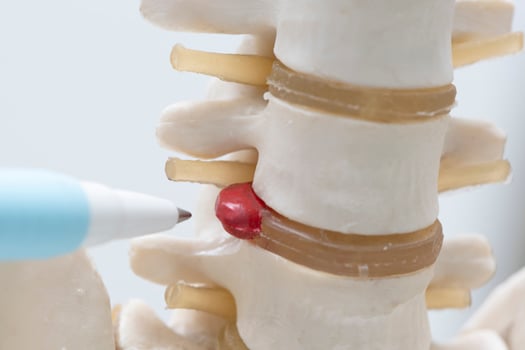
The do-it-yourself approach is often appealing in many situations. In some cases, the DIY approach to herniated spinal discs can also be effective, especially if you act early when you first begin to experience symptoms of a herniated disc (also commonly known as a "slipped disc" or “ruptured disc”). Whether you experience these symptoms or not often depends on several factors.
Mild Symptoms
If you only have mild symptoms, you may be able to enjoy relief with self-treatment. In this instance, you are modifying your daily routine so you are not overstressing your spine and the affected disc or discs. Self-treatment also involves:
• Improving your posture
• Watching what you eat
• Not sitting for long periods of time
• Getting regular exercise
• Taking a break from sports or similar activities that may be too stressful
• Using lumbar support belts or cushions to give your spinal disc time to heal
Self-treatment can also involve medication to control or ease pain and inflammation. Make sure to check with your doctor first, especially if you take medication for other reasons. Common anti-inflammatory medications include aspirin and ibuprofen.
Moderate Symptoms
Just because your symptoms are a bit more noticeable does not mean you will not benefit from self-treatment. Self-care for a herniated spinal disc can also involve steps you take in addition to seeing your doctor, such as getting chiropractic treatments. However, if your discomfort worsens or does not go away after 3–4 months, visit your doctor or a spine specialist.
Severe or Disruptive Symptoms
If your herniated disc symptoms are severe or disrupt your daily life, see what your doctor has to say. Oftentimes, severe herniated disc pain requires surgery. The most common option is a discectomy or a minimally invasive microdiscectomy. Self-treatment is rarely effective for severe or disruptive symptoms. The only exception is if the symptoms subside or become less of a distraction after initial rest or activity modification.
Receiving an Accurate Diagnosis
It is important to get an accurate diagnosis if self-care is not effective after a few days. Doing so gives you a better idea of the source of the symptoms in the affected spinal disc so your doctor can determine the kind of treatment you need. Remember, you can always start out with self-care and try other treatments your doctor recommends. You can also use self-care to supplement treatments such as physical therapy. Your doctor can help you put together an approach to treating your spinal disc pain that works best for you. Self-treatment can also involve:
• Applying heat or ice if you overdo it or have pain flare-ups
• Taking a break if an activity is causing spinal disc discomfort
• Using proper lifting techniques so you are not overstressing your spine
If self-treatment and other conservative methods do not relieve the pain from a herniated disc, treatment recommendations may include a discectomy or a less invasive microdiscectomy. Although this is generally a very successful procedure, patients with a large hole in the outer ring of the disc have a significantly higher risk of reherniation following surgery. Often, the surgeon will not know the size of the hole until beginning surgery, and having a large hole in the outer ring of the disc more than doubles the risk of needing another operation. A new treatment, Barricaid, is a bone-anchored device that closes this hole, and 95 percent of Barricaid patients did not undergo a reoperation due to reherniation in a 2-year study timeframe. This treatment is done immediately following the discectomy—during the same operation—and does not require any additional incisions or time in the hospital.
If you have any questions about the Barricaid treatment, ask your doctor or contact us at 844-288-7474.
For full benefit/risk information, please visit: https://www.barricaid.com/instructions.


Comments